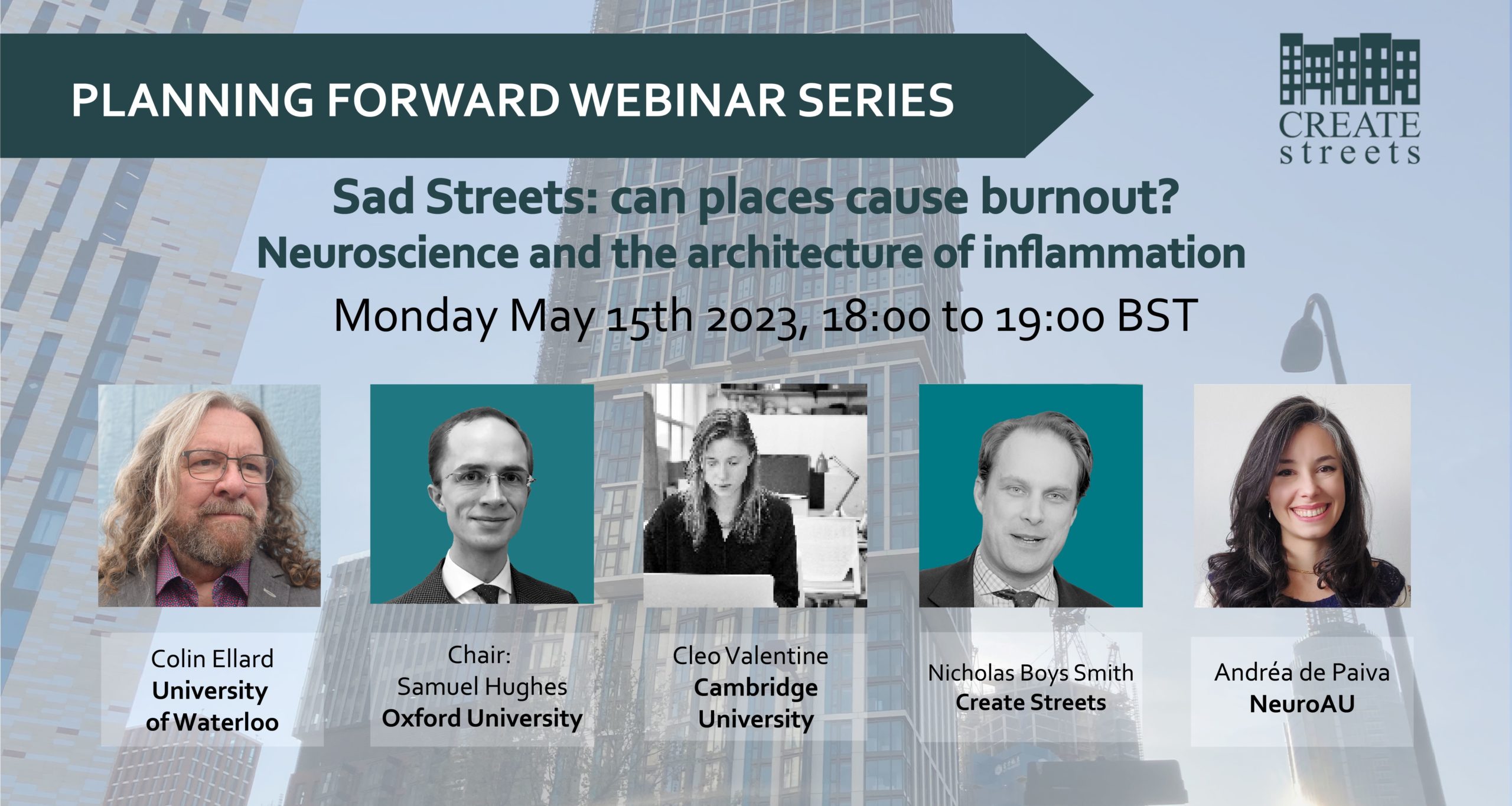It was very thought-provoking and enjoyable to be part of our Sad Streets webinar on Monday 15 May. Can places make you sad or happy we asked ?
Not being a neuroscientist, I made my contribution early and kept it short and sharp.
I told the story of how over ten years ago, as I started the research that led to Create Streets, I was frequently told things as revealed truth by experienced and well-intentioned professionals which seemed to me to be deeply implausible at best or straightforwardly wrong at worst.
I was told quite often for example that “what things look like does not matter.” I recall a director of research at a global firm telling me that in one of my very first meetings. A very senior official at the Greater London Authority said the same. (And, in fact, an architect only a few weeks ago agreed, referring to the outside of a building as “superficial.”) But can this be true I thought? About 90 percent of the information transferred to our brains is visual. And we process visual information incredibly Intuitively and quickly. Can it really be merely secondary to our experience of place?
“Beauty is in the eye of the beholder “is another standard cliché. Ultimately of course we are all individuals with our own tastes and influenced by our own personal history and experiences. But all my early practical experience just did not agree that the types of places we like was an utterly random response to a Brownian motion of purely self-directed individuals. I recall the very first neighbourhood design workshop in which I participated with London Citizens on an estate in South London. The responses of a lovely small group of Eritrean and Somali mothers to the types of places they liked and did not like was identical to my own. In fact, it was very much that meeting that gave me the confidence to quit my job and set up Create Streets.
Our subsequent research very firmly finds that there are predictable relationships between place and value demonstrating some profound levels of predictable human response to the environment. For example, Beyond Location, our study of every property transaction in six British cities was able to predict 54 per cent of sales price and 74 per cent of index of multiple deprivation from urban form and design alone. Something is clearly going on.
I personally had three key takeaways from the fascinating and informative conversation that followed.
Firstly, like it or not, the neuroscience of architecture is coming. Our understanding of the relationship between place and well-being remains imperfect but it is growing. And it is going to keep growing. Much more work remains to do done though. As Cleo Valentine of the University of Cambridge reminded us though, “more research is needed.”
Secondly, the range of factors which we now understand influence human responses to place is also growing. The beneficial relationship between greenery and well-being in most circumstances has long been understood. But we now understand with growing clarity the relationships between physical movement, light, interest, control of privacy, noise and facade quality as well. As Professor Colin Ellard of the University of Waterloo and author of the excellent Places of the Heart put it “facades devoid of complexity “don’t make us happy. These relationships are not necessarily binary and straightforward but there are clear “slopes” in the data.
Thirdly, as Cleo Valentine put it, there is “a gap in our healthcare protocols “ with doctors and health professionals only slowly and, so far, very imperfectly making use of this research. I recognise this. Social proscribing is starting to accept the benefits of greenery and to understand how urban design can encourage personal movement but there is much further to go. The recent NHS Healthy New Towns programme was very disappointing as it only responded to a very limited subset of the available research.
There is more positive news on the response of the built environment professions to this growing corpus of research. My personal experience has been very mixed with some architects and architectural writers remaining apparently completely ignorant of it. However, reassuringly Andréa de Paiva of NeuroAu reported that a growing number of architectural firms are now employing architectural neuroscience consultants. Great news.
One final thought: if you’re interested in research into place quality and human responses and health, there’s a great job going right now at the office for place whose advisory board I chair as research lead for the Office of Place. You can see the details here.
Thanks to all our expert contributors , to our fellow Samuel Hughes for consummate chairing of the discussion and to the team at Create Streets for making it all work.
If you missed it, you can watch the discussion here.
Nicholas Boys Smith is founding director of Create Streets


